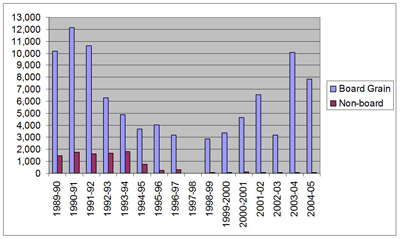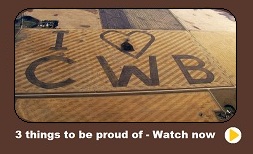Memo to to Saskatchewan Producer Car Shippers
From: Donna Welke, former Assistant Commissioner for Saskatchewan with the Canadian Grain Commission October 2011.
Lies Someone Told Me
© Paul Beingessner 03/11/08
Editor’s note: the late Paul Beingessner wrote this column in 2008 but the information is relevant to the debate on the CWB single desk. Since that time the Battle River Railway has been formed to load producer cars in Alberta. Read about this new generation Co-Op here: www.battleriverrailway.ca
Of all the lies told about the future of the CWB if it loses its monopoly, one of the biggest is the idea that producer cars and short line railways will somehow survive this sea change. They won’t. At least not the ones in Saskatchewan, which is home to all the short lines that exist on grain dependent branch lines. There are, in fact, seven of these. They are the Great Western Rail, Southern Rails Cooperative, Red Coat Road and Rail, Fife Lake Railway, Wheatland Railway, Thunder Rail, and Torch River Rail.
Other short lines on grain dependent branch lines operated for a time in Manitoba and Alberta, but eventually failed. The striking difference was the fact that the railways that failed in Saskatchewan’s sister provinces were owned by private investors. The seven short lines in Saskatchewan are all community owned. And, while they do move other traffic, all are heavily dependent on producer cars for the majority of their traffic.
The short lines in Saskatchewan started life as attempts to retain grain handling options for farmers. They were seen as means to an end. Maintaining the railway would not only allow farmers the option of loading producer cars, it would also allow for the possibility of other economic development initiatives in the community. Alberta’s and Manitoba’s grain dependent short lines were started and owned by private investors wanting to make a buck. Without a substantial grain elevator presence, which the short lines do not have, there is no buck to be made owning a grain dependent short line.
There may be, however, survival, if the short line attracts enough producer cars and other traffic to pay the bills and maintain the track. While it has been a tough business, the older short lines, Southern Rails, Red Coat and Great Western, have been able to do just that. They have also succeeded to some extent in the economic development game. Red Coat garnered a rail car repair facility, Southern Rails gained a pulse processor, and Great Western operates its neighbouring short lines – Red Coat and Fife Lake. The latter has a kaolin mine.
But producer cars remain critical to their survival, and survival is a year-to-year thing. Producer cars themselves depend entirely on the CWB. Ten or twelve thousand producer cars of CWB grains move each year, mostly from short lines. Though farmers grow millions of tonnes of canola, peas, flax and lentils in Saskatchewan, virtually none of these move in producer cars. Nor will they, since the grain companies that control these crops don’t want to lose the lucrative handling charges they make by moving them through their country elevators.
With the CWB, producer cars work for two reasons. One is price pooling. Price pooling works because the CWB has a monopoly over export sales of wheat and barley. Its overwhelming position in the market means it makes sales year round, into all available markets. This allows farmers to have confidence in a pooled price. Without the single desk, the CWB’s dominance disappears, as it has to rely on its competitors to handle grain for it both inland and at port. Its sales would be limited and price pooling would be a scary prospect for farmers who wouldn’t know how large or small the pool might turn out to be.
The second reason producer cars work now is the CWB’s ability to take part in the railways’ car ordering systems. Small blocks of cars have a low priority for the railways, but the CWB’s size gives it flexibility to allocate cars to producers. Without the CWB, a farmer wanting to load his own car could still get one, if he could find a terminal that would take his grain and allow him the advantage producer cars currently allow (not something they do now). But he would get that car at the railway’s leisure. This is not a happy prospect for someone selling into a spot market that needs timely delivery.
Without a dominant CWB, producer cars might exist in theory. Their practical use would be almost non-existent. And without virtually all the producer cars they now obtain, short lines would rapidly fail. Their debts and high track maintenance costs would ensure this. And with them would go other community investments on their tracks and any future economic prospects that depend on rail. That, sadly, is an economic certainty.
Further Notes
Farmers know their right to order railway grain cars goes back over 100 years. It was put in place to make sure inland elevator companies could not hold farmers to ransom by restricting access to the rail system and the big terminal elevators at port. However, too many farmers do not understand just how important and profitable a producer car can be. With a producer car a farmer is dealing directly with a federally regulated terminal at one of the major ocean shipping points.
Talk about cutting out the middle man! Their grain is graded and measured for dockage by a Federal inspector, not the company agent at an inland elevator. In fact many producer cars are graded as having zero dockage. Try that at your local elevator! There is more: by cutting out the middle man, the farmer saves all the costs of paying the elevator to put his grain into a rail car. Many producer car shipping points are closer to farmers than the nearest inland terminal, so trucking costs come down too. Using a producer car a farmer can save literally thousands of dollars.
The elevator companies and the railways are always looking for ways to prevent farmers from using producer cars and they may have found one: get rid of the Canadian Wheat Board. Since the export terminals are owned by the same companies that own the inland elevators, they have no incentive to compete against themselves and handle producer cars at port. This is why non-board grains are almost never shipped in producer cars. It is not that farmers do not want to; but there is no Wheat Board to insist that companies honour the rights of farmers to ship producer cars. This is why over 95% of producer cars contain Board grains. Only the CWB has the commercial muscle to make sure farmers can use producer cars.
 Board verses non-Board grain in producer cars
Board verses non-Board grain in producer cars
For more details go to the CWB web site at www.cwb.ca/public/en/farmers/cars

